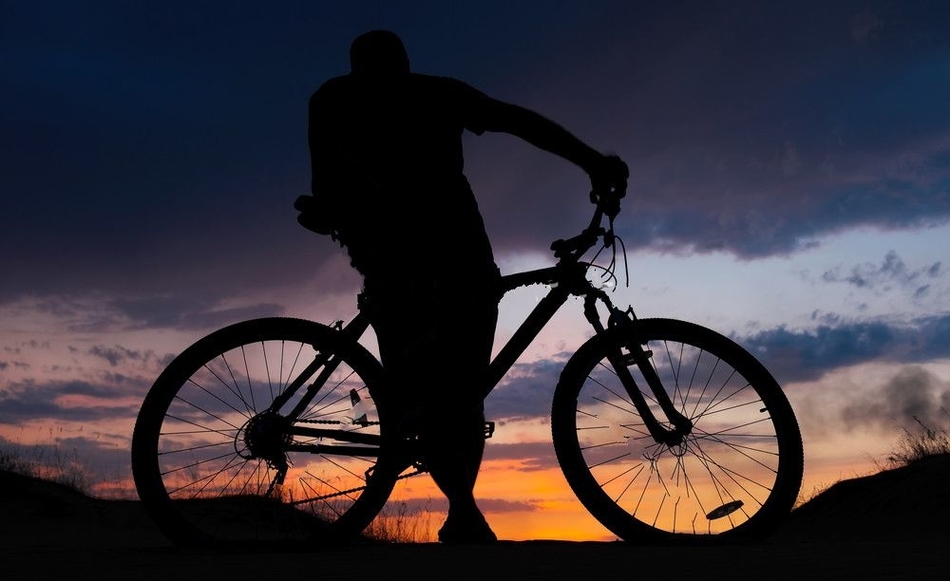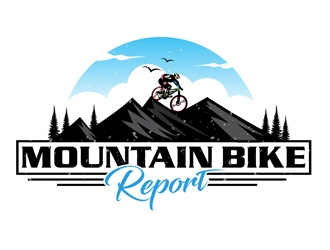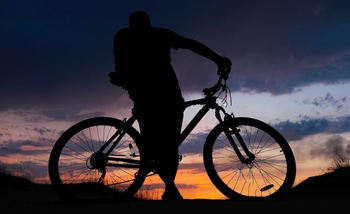
Riding your bike at night can be a lot of fun and a completely new experience. But mountain biking in the dark can also be risky and dangerous if you are not prepared with the right gear and the necessary skills. Below you will find important dos and don’ts to help you succeed while riding at night.
1. Do get a good set of lights for your handlebars and your helmet.
Lights on your handlebars will help you to see further down the trail. You will be able to see any small obstacles ahead of time before it is to late. Lights on your helmet are very important so you can see around corners and know your exit.
2. Do have handlebar bike lights with at least 3600 lumens.
When it is night time it is very dark outside. Especially if you are riding in a forest even when there is a full moon trees won’t let in any moon light. You need a handlebar light that can illuminate far enough down the path.
3. Do have helmet lights with at least 1500 lumens.
When biking in the dark you are going to need to turn your head left or right when a turn comes up. You should be able to see far enough around the turn for you to know where your exit is going to be. The turn will come up too fast if you don’t have enough illumination.
4. Do ride with both handlebar lights and a helmet light.
Riding with only one or the other is not going to be enough for you to see where you are going. Having only a helmet light will not be enough to see far enough down the trail. Handlebar lights will not allow you to see around any corners or turns that will come up. Having only one or the other will likely cause you to crash in the darkness.
5. Do have a good rear bicycle light.
You need to be seen by other riders for safety, plus it is the law. If other riders can’t see you they may end up crashing into you. In this type of situation you will be the one at fault for not having a rear bike light. Because you are mountain biking in the dark it is probably a better idea to get a flashing light. Get one with at least 250 lumens.
6. Do know how much burn time your bike light has.
Burn time is how long your bike light will last when it is on maximum power. This will help you to know how far you can ride into a trail before having to turn back before your lights go dark. To give yourself more time you don’t have to have your bike lights on full power all the time.
7. Do check to make sure your bike lights are fully charged before you go out riding at night.
Bike lights take many hours to charge so if they go out, that’s it, darkness. Also, both the handlebar lights and your helmets light needs to be fully charged. One with out the other will make riding much more difficult.
8. Do set up your bicycle lights properly before going out at night.
This is especially true for the handlebar lights. If the handlebar lights are fastened and the light beam is pointing too far down toward the front tire, you will not be able to see far enough down the path to avoid any obstacles. Same with the helmet light make sure it is positioned correctly so you will see upcoming turns and exits.
9. Do be sure to have backup lights for both your handlebars and your helmet.
For whatever reason one or both may go out. If either one does go out it makes it that much more difficult to ride. Having a backup ensures you will never run into that kind of situation.
10. Do have a backup battery.
Even though you started with a fully charged battery you never know what could happen. Maybe the battery you currently have has been used a lot and becomes no good. There is know way to know when this might happen so a backup is a good idea.
11. Do always bring your phone with you when riding.
Especially when you are riding at night. Even if nothing bad happens and you are riding with other riders you have a way to get in touch with them if you get separated on the trail. Then you can stay in touch by phone until you find each other on the path again.
12. Do have an emergency contact number on your phone.
Be sure to put it on your phone at a place where it is easy to find in an emergency. This person could be one of your fellow riders. But it may be better if it is someone who can come with their car to help you, or someone who can bring the police or an ambulance. Then you can stay on the phone until they find you.
13. Do have a spare tire tube, one for each wheel, front and back.
If either of your tires goes flat because of a hole and you don’t have a spare tube, no fun. You will have to walk back to civilization. This is no fun, especially at night. On some parts of the trail you may need to carry your bike.
14. Do have a bicycle pump for flat tires.
If you are many miles out on the trail and you get a flat, but have no bike pump, get ready to start walking. If you ride your bike while it has a flat tire you could damage the frame of the wheel. That would mean possibly needing to get a new wheel. Make sure the pump is compact so you can easily store it and carry it with you.
15. Do carry some CO2 cartridges.
CO2 cartridges enable you to inflate your tire quickly. This is great when you don’t have a lot of time. Maybe your bike lights are running low on power. Or you get a flat and it has just started to rain, and or it is starting to get colder outside.
16. Do know the trail you will ride on.
Riding at night is very different than riding during the day. The trail at night will look as if it is a brand new trail at night. Familiarize yourself with the trail first by riding it during the day. Take note of any landmarks you see so it will be familiar to you at night. You might even want to map out the trail during the day, then try to remember the path in your mind before you go out riding it at night.
17. Do make sure someone knows where you are going and when you will be back.
Someone back home should know which trail you will be on and about what time you will return. If you are late or they see you are late one of you can then call the other and find out if there is some sort of situation.
18. Do wear a helmet when riding.
Riding at night mountain biking is more dangerous than during the day. So it is even more important to wear a helmet, not too mention you also need your bike light on your helmet. The worst place to injury yourself is your head because if you are hit hard enough you may become unconscious.
19. Do wear a pair of glasses.
Protect your eyes with good safety glasses. Sometimes the front tire kicks up dirt and debris toward your face. Eyes can easily be damaged, and it is not worth risking. Also you can protect yourself from other riders bright bike lights. They may shine their helmet light right into your face without noticing they are doing this.
20. Do wear a pair of good riding gloves.
At night especially, you want to make sure you have a good grip on your handlebars. Make sure they fit the size of your hand properly and they are comfortable. Plus if you take a tumble gloves will protect your hand and cushion the impact.
21. Do wear knee pads.
Strong knees and the muscles and ligaments in that area are very important for pedaling. You should protect your knees from hitting a tree, scraping the ground, and from colder temperatures due to lower degrees and from the wind of riding fast. A serious injury to your knee could keep you off your mountain for weeks or months.
22. Don’t have your bike lights on too brightly.
Depending on the trail you are riding on and the trees and bushes in the area, if your lights are very bright, the light may bounce back to you. Leaves can be reflective and send light back into your eyes temporarily blinding. This could cause you to crash.
23. Don’t ride during twilight hours.
Depending on when your sunset is you don’t want to ride during the time the sun is setting. Your bike light are not as effective during this time at helping you see and neither are your eyes. It is much better to wait until the sun has fully set and it is properly night and dark. If not you could crash because it is more difficult to see when it is between day and night.
24. Don’t ride alone.
Riding by yourself is more dangerous than if you are riding with your friends. This is especially true at night. You are the only on the trail and everywhere else is dark. If you get into trouble or you get lost or crash, there is no one around who can immediately help you. Even if you have a phone you will have to wait for help to arrive.
25. Don’t get air when jumping.
If you are riding and you are going to hit a jump for the first time, your lights are going to give you a black spot just before the jump. If this happens you won’t be able to see where you should be taking off from to get air. In this case you need to have a friend light up the jump for you. If not then do not get air when going over the jump. It is too dangerous.
26. Don’t blind your friends with your bike light.
When you are with your friends try not to point your bike lights at your friends. These light are bright and will cause their pupils to become smaller. They will then have temporary night blindness until their pupils dilate or become wider again and adjust to the darkness.
27. Don’t create big shadows on the trail.
When you are riding with your friends or other people, make sure to give them enough room ahead of you. Otherwise you will create shadows of them. They won’t be able to see the trail properly or notice any small obstacles. They may think something is there when it is not, or think something is not there when it is. Shadows can be tricky.
28. Don’t ride without reflectors on your bike and clothes.
Other riders will be able to know where you are as their light reflects off you. Be sure to add reflectors on the front of your upper arms and forearms, and on the front and sides of your thighs. Add them to your bikes frame and other riders will know you are coming.
29. Don’t leave home without GPS for your bike.
You could get a GPS smartphone but a dedicate GPS device for off road riding is even better. You will be able to see full color maps of the trail you are on. Pretty cool. You will be able to see and plan ahead of time where you want to go which is especially helpful at night.
30. Don’t leave home without night vision goggles for mountain bikers.
This idea may not be for everyone, but it is pretty cool to know that they do exist. Night goggles are a bit heavy to wear, and they may effect how you wear your helmet. Plus you won’t have as much peripheral vision as you normally would. If you are adventurous give it a try.
31. Don’t leave home without warmer clothes.
During the nighttime the temperatures drop a lot as compared to the day. They drop enough that you should wear an extra layer of clothing. With colder temperatures come wetter conditions. So the clothes you wear should be waterproof even though it may not be raining.
32. Don’t leave home without snacks and a drink.
Having some food and a warm drink can be helpful if your stomach becomes hungry. A small snack like peanuts, raisins, or candy is easy to carry and easy to eat. Since nights are cooler tea or coffee is a good idea, if it is a summer night water is the best drink to quench your thirst quickly.
33. Don’t go down hill too fast.
When you are going down hill fast at night there is a good chance that you will out run your bike lights. As soon as you see something ahead on the trail you are already there. This gives you know time to prepare or avoid it if you need to. If it is something dangerous, you’ll be sorry.
34. Don’t pedal at all when going over small obstacles at night.
Even though you have your handlebar and helmet lights on you are going to have blind spots. The main blind spot is your peripheral vision down by your feet. There can be some small obstacles which can catch your pedals. You will need to time your pedal strokes so you won’t hit them or just do not pedal at all when going over them.
35. Do reduce the air pressure so the suspension is not too bouncy.
At night it is riskier to go off road riding so you want your tires to have more grip. This is done by reducing the suspension on your bike. This is easy, just release the air pressure, and adjust the dampening so the spring will not rebound as much when it is compressed.
36. Do use your bike lights correctly when doing drops and jumps.
When you go over a drop there are going to be shadows. This is where a headlight will light up the shadows that happen just after a drop. It will also light up dark areas right in front of the drop. You can also have a friend brighten up the area for you. Finally don’t test out new jump at night, its too risky, and not worth it.
37. Do slow down when going over roots and rock in the dark.
Even if you have bright lights there are still going to be some shadows from the roots and rocks. You won’t be able to see just how big they are clearly, so it is better to slow down. Plus the shadows will make it more difficult to stick to a line. Try also unweighting yourself so you go over them more lightly.
38. Do use your helmet lights to corner to avoid crashing.
When cornering at night the helmet light is critical to use properly. As you enter the turn you need to turn your head so you can look past the beginning of the turn toward the exit. This is very important because the handlebar lights will only let you see straight ahead, and your helmet lights do the same thing unless you turn your head and direct the light in the right direction.
39. Do set up a meeting point.
Having a rendezvous location set up with your friends and other riders for safety is a great idea. You should all agree on where everyone is going to meet and the time everyone will meet there. Then check that every rider is there.
Riding at night is fun and risky. I hope you put into practice the information above so you will enjoy a safe and happy night ride on the mountain.

